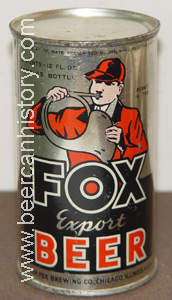

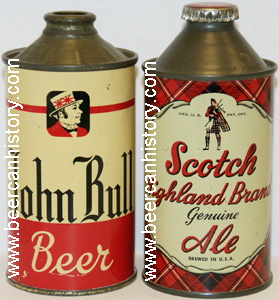
 |
 |
 |
| E is for El Rey Brewing: (Sept/2011) El Rey Brewing in San Francisco was on outer Mission St. in the 5000 block and canned beer in one of the most colorful groups of low profile cone tops by any 1930's brewery: three variations of Eagle Beer, two variations of Tornberg's Old German, Leidigs Dutch Mill, Gold Age, and by far the most common brand found by collectors, El Rey Beer. The brewery's name was changed to Albion in July, 1938, and to Eagle in 1941 with the brewery closing in 1942 per detailed records of California breweries kept by a group, California Brewers Association. (The California Brewers Association had an office in the Russ Building in San Francisco until the later 1970's, but what happened to the group's many records hasn't been learned at this time.) |
|
In December, 1936 of the breweries in California that sold beer in cans, El Rey Brewing was among the smaller ones with sales only ahead of Grace Brothers Los Angeles, Globe Brewing of San Francisco, and Salinas Brewing. Gold Age Beer cone examples by El Rey Brewing have only been found in limited numbers. Very few beer cans have documentation on the holders/circumstances that allowed a can to be preserved fully going back over 70 years or more. However, such records do exist for a Gold Age Beer cone - another example than the one pictured above in the El Rey group. Dan Baker (BCCA Member #2048) through his contacts, found a Gold Age cone in 2014 that likely has one of the best provenances for any beer can. The granddaughter-in-law of the original purchasers helpfully wrote the 4/27/14 letter below describing well her relatives moving to California from Nebraska after 1929 and adding some background on following years. While in California, they brought a Gold Age Beer "to share". The empty cone was kept in the family until 2014, serving as a "testament to their marriage" and was displayed on the relatives' Anniversary Day.
|
|
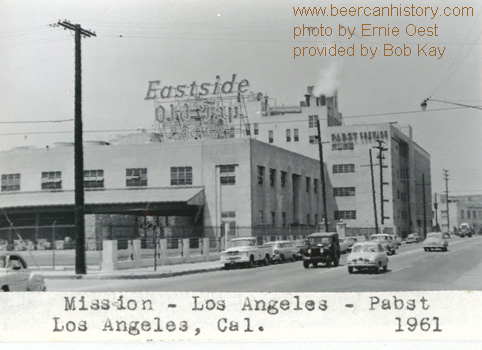 |
||
E is for Eastside Ale: (Sept/2011) Los Angeles Brewing was a major California brewery for many years with their popular "Eastside" beer and the name is connected with the brewery's location being just east of the Los Angeles River. This metallic Ale can is from the unusual group of 1930's cans originally in a Chico, Calif. bar collection that was obtained by Randy McMahon (former BCCA #31597) Top |
||
 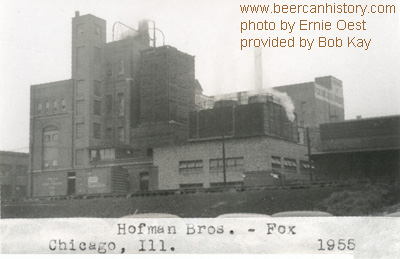 |
F is for Fox Export: (Sept/2011) An "Export" label from the large Fox Brewery of Chicago. Top |
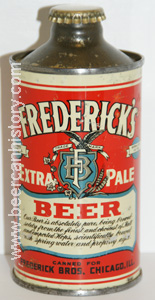 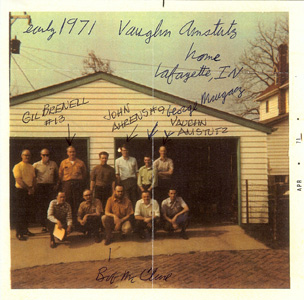 |
F is for Frederick's J spout: (Sept/2011) A rare cone from the small Thornton, IL brewery, examples of which were first found in 1972 by Vaughn Amstutz of Lafayette, Indiana who first was an active collector from the 1960's on. Vaughn found several six packs of grade 1+ Tavern beer in 1970, and ran ads uncovering other cans. Vaughn stood out as one of the most dependable and reliable traders whom many collectors wanted to network with and was an early trader, outside the New York area, with Joe Veselky in the 1960's. The picture shows a gathering at his home in early 1971 with several BCCA President's and Hall of Fame winners attending. |
The Frederick's J spout pictured is one of the ones Vaughn found, the best of which are around grade 1, down to grades 1-/2+ due to scratches. Marc Tracy, the J spout specialist, thinks the only other non-dumper example of the can that has turned up as of summer of 2010, is one that was in Bob McCoy's collection, which reportedly found at Notre Dame during a remodeling project. Dumper examples are scarce too. This Thornton, IL brewery had another J spout, Pilsener Light Lager, which is more common. Top |
|
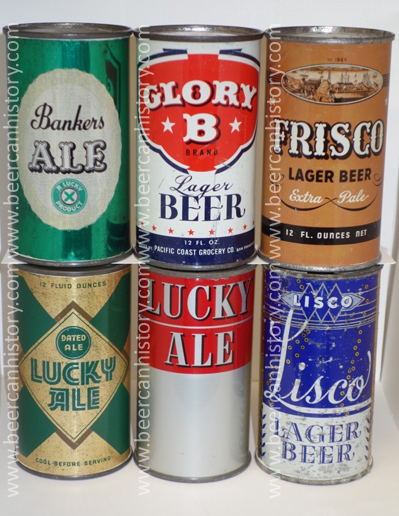 |
G is for General Brewing Corp. - minor brands from the 1930's: (May/2016) In the later 1930's General Brewing Corporation was the 3rd largest California brewer behind Acme and Rainier Brewing. With its popular "Lucky Lager" leading the way, the brewery grew rapidly and by the late 1950's peaked as the leading beer seller in California. Including several other brewery plants in other states, Lucky during that time had become around 12th largest national brewer. However during the 1960's, Lucky Lager fortunes changed completely as it steadily lost market share to Coors, Olympia, Budweiser, etc. Lucky Lager Beer cans from the 1950's are among the most common ones found and dumped in its marketing areas. In contrast, the picture shows five minor brands from the 1930's-1940's that have been found on-grade in only limited numbers, and in lesser amounts from dumps too: (*footnote at end for Lucky Ale "Christmas" can that has never been dumped, so isn't included.) |
Top |
|
G is for Globe Brewing Company, San Francisco: (Sept/2011) Globe Brewing Company was a very small brewery in San Francisco that closed in August, 1938. It was located at NW corner of Greenwich and Sansome Streets directly below Coit Tower and what has been the Julius Castle Restaurant. Of breweries in Calif. that canned beer, based upon a 1936 ranking of breweries using information at the former California Brewers Association in San Francisco's Russ Building, only Salinas Brewing ranked smaller. |
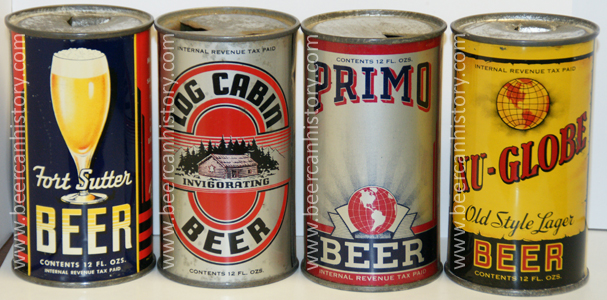 |
In the past, information has been limited on the employees and background of the Globe Brewing Company. However in 2010, Gary Flynn for his www.brewerygems.com prepared a very detailed description of the brewery and its activities that is now under the website's heading, "Brewery Histories", which goes along well with the many other informative topics Gary has done. Within a three year interval, Globe sold canned beer with four interestingly designed labels, Nu Globe, Fort Sutter, Log Cabin, and Primo - with the last now being Globe's rarest brand in cans. These four labels in "store condition" were among the many earlier California beer cans saved by Charles Coffey, who started in a small Sierra town in 1936. Helpfully for collectors, several of these brands - often with one on-grade side for display - have been dug in fairly good numbers from dumps in the Sierra Mountains. Around 2005, five grade 1 and better Log Cabin cans were found in a house wall, reportedly in the Mt. Shasta area, but on-grade examples of the other brands are scarce. |
|
 |
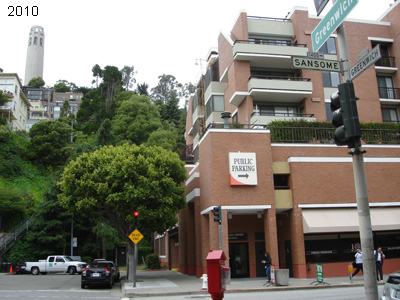 |
| The picture of Globe Brewing in San Francisco was taken by Ernie Oest - one of many photos of brewery buildings Ernie took from the 1940's to 1960's - and provided by Bob Kay. Ernie called this brewery location "Acme", as his first interest were labels and sometimes gave the brewery name of the Pre Pro brewery at a location. The color picture is of the same corner, Sansome and Greenwich, but many years later in 2010. Globe Brewing operated in a warehouse property - one of several owned in that area by owners of the Brewery. Top | |
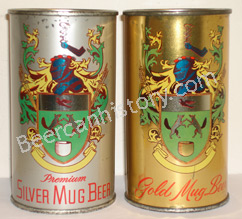 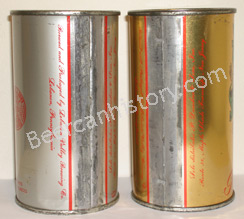 |
G is for Gold and Silver Mug cans: (Sept/2011) Two metallic cans by Lebanon Valley Brewing Co for "P. Donohue and Son, Rt 38, Maple Shade Township, New Jersey. Later 1950's cans with one of the more intricate label designs that understandably tend to tarnish and limited numbers of on-grade examples are in collections. Dumpers are also only found in limited numbers in poor condition. Top |
| G is for Golden West, Goebel and Pacific Brewing: (Sept/2012) Just east of the present "Oakland West" BART station was located the Golden West Brewery and in that location was a brewery that operated before Prohibition - shown is a factory scene beer tray; Ernie Oest's photo of the former brewery building in 1961; and the can picture shows a small variety of selected cans from the three breweries. Golden West sold out to Goebel Brewing of Detroit in 1949, operating under the name Goebel Brewing Co. of California, but that venture ended in 1955. However, the brewery building was used again during 1958-1959 as Pacific Brewing, which had over 20 graphic and often metallic labels. Top | |
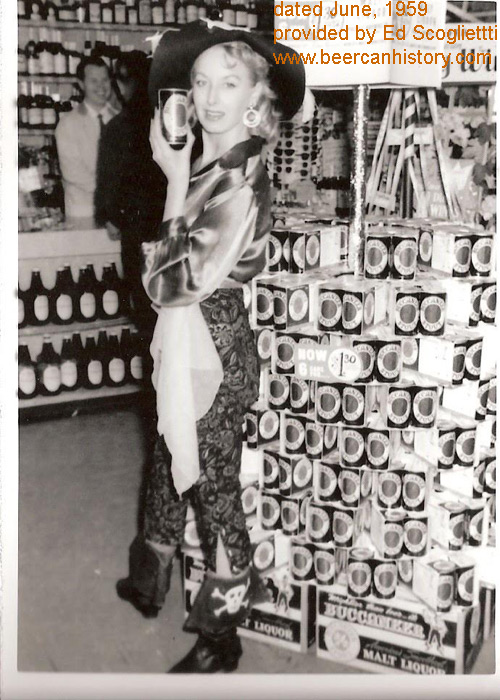 |
|
|
All the Pacific Brewing brands collected by Dan Scoglietti (BCCA member) |
 |
G is for Grace Bros. Ale - Los Angeles: (Sept/2012) Grace Brothers Ale cans were produced during the 1930's at the Santa Rosa brewery and also at its Los Angeles brewery on Rio St. - which Grace Bros. started in 1937, and ended under the name, Southern Brewery. The can pictured was bought by early 1970's Los Angeles collector Ken Jerue. The background on this Grace Ale is recalled by Glenn Hintz (BCCA member): Around 1975 Dennis Fry, a local "picker", offered several beer cans at show in the Los Angeles area and sold them to Ken Jerue. Among the cans were several different average-type Grace Brothers cans but highlighted by the Grace Ale from Los Angeles. Information was passed on that the cans had been found on the roof of an "office" structure that had been built inside of a large LA warehouse - the cans were left or thrown up there. Grace Ale cans from Santa Rosa are scarce, but this example from Los Angeles is one of the very few passably on-grade examples; and unusually, shows a short-cut printing approach by using black stamp markings for the brewery location on the label. |
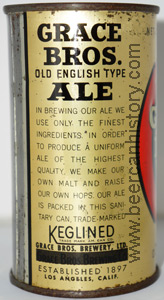 |
Ken Jerue was one of the more colorful early 1970's collectors who attended several Canventions from Geneva on. In his scrounging around Southern Calif., he found a number of better cans and last lived on Brookhurst in Fullerton, Calif. He accumulated several collections, selling the first one to Ron Moermond around 1973; then starting another collection but died driving down the highway from Lake Arrowhead around 1976. Wally Gilbert ended up buying Ken's Jerue's cans, which then included this Grace Ale. Ken Jerue's interaction with Wally Gilbert was typical for how many collectors found Wally. Offering a balanced view on Wally, he was hospitable when talking about cans and showing his collection to visitors, such as Dave Lang, Ed Scoglietti and others found when visiting. |
However for those who were interested in making a trade or purchase of cans that Wally rated well or didn't have many extras of, Wally changed to a hustling style with the most frustrating and time-consuming routines - Dave Stark is known to have stayed many times late into the night working a deal. The example below involving Ken Jerue has been recalled by Glenn Hintz and has a confirming ending over 30 years later. When collectors tried to make deals with Wally Gilbert, after a while most gave up and walked away with no deal completed. However, Ken Jerue wasn't that type, and with his motivation helped by the flow of beer, rarely left quietly. In 2006 after Wally died, Glenn Hintz was among those who looked over the many cans scattered around the basement and outside. In the crawl space behind Wally's main can room, Glenn scanned the mass and was seeing only "toss out" and lowest-end cans. However he saw one can that connected - sitting on a 2X4 framing was a crushed/scratched Golden Gate. To anyone else, the remains of that can wouldn't be much noticed, but Glenn recalled a long ago event with Ken and Wally making a deal that underscored Wally "never threw out a can." |
|
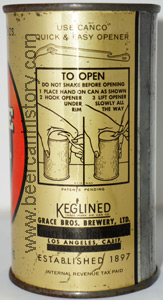 |
Back in the early '70's, Glenn was visiting Wally with Ken Jerue and watched Ken trying to buy a Golden Gate can. Glenn observed nearly an hour of Wally's frustrating and unvarying routine that was encountered by most collectors persistent enough to keep going towards a deal: "What will you pay, etc."; Wally followed the old approach "he who offers first, loses" for any cans not price- marked; Wally never gave a price until long into the negotiating process as he wanted to pull out offers-upon-offers to see how high a person would go when pushed "give me your best offer"; then upon hearing their "best offer", Wally mostly responded, "No, worth more"; then in time Wally might say, such as in this case, "Will you pay $5?, etc." and if somebody did say, "Yes" and expecting the deal was done, Wally typically responded, "let me think about it...". However shortly later, Wally often fiddled around taking more time with, "Don't get mad, maybe we can do a deal" or "I'll write you, etc." |
|
Ken was unusually persistent on the Golden Gate that time and did buy it after an hour for $5. A second after Wally handed it over, Ken threw it to the floor and started stomping the can until fully scratched and crushed. Ken kicked it back with a stream of words describing all that he found wrong with Wally, ending with something like: |
|
H is for Haberle's Congress Beer: (July/2013) Haberle Brewing Company merged with several other Syracuse, New York breweries around the turn-of-the-century, and continuing after Prohibition, was renamed as Haberle Congress Brewing Co. While more information from brewery materials would provide full confirmation, apparently the new name for the brewery was selected to highlight Washington's success ending Prohibition. Before Prohibition, Haberle had had a "Congress Beer" label with a small, black and white picture of the Washington Capitol, but in the later 1930s packed "Haberle's Congress Beer" in a metallic can with a colorful and detailed view of the Capitol. |
||
| Haberle Congress Brewing Co. grew to be Syracuse's largest brewery, but reflecting the business pressures faced by all regional breweries in the 1950s and 1960s, went of business on December 31, 1962. Of the two cones pictured, the "low profile" Haberle's Congress Beer in on-grade condition has been the rarest cone from the brewery and was located by one of Tom Leo's (BCCA member) sources in the Adirondack's. A number of mostly tarnished "low profile" Haberle's Congress cones have been dumped in that area, but apparently the distribution of Haberle's Congress Beer in the 1930s to other areas was limited. The "high profile" Haberle's Congress Beer has been scarce in Grade 1/1+ condition and higher. | ||
| "Low and high profile" cones: Haberle Congress Brewing had two brands in 12oz "low profile" cones starting in the later 1930s - Haberle's Congress Beer and Haberle's Light Ale, along with the same designs in quart size. After World War II, the two brands were continued using "high profile" cones with the same label design - a matching pattern for the two cone-topped versions that was done for over 25 brands sold by other breweries too. | ||
| The photo above serves as an example of Continental Can's two types of cone-topped cans side by side: The "low profile" cone, to the left, was shorter in height overall but with the rims slightly higher and the can was heavier due to thicker gauge steel, as compared to the "high profile" cone in the center. The "low profile" cone design by Continental Can was first sold in 1935. While used in that year by one of the three largest brewers, Schlitz Brewing Co., the cone-topped design was mostly bought by smaller local/regional brewers who could fill cone-topped cans on their existing bottle lines. The "low profile" cone design mostly was stopped by the World War II years, but continued to be produced during the war for a few "olive drab" cones by several breweries; and the "low profile" design was possibly used by some breweries for a few years after. However, in the late 1930s Continental Can had also designed another cone-topped can, the "high profile" version. While this "high profile" cone-topped design continued to be used for many more years, through the 1950s (actually until late 1961 by The Renner Co.), with the decline in smaller breweries the flat top beer can had become the dominant can design for beer. Continental Can in the late 1930s had identified early this packaging trend and also began making flat top cans - by 1957 it had a 47% share of the beer can market (the "47%" is per Continental Can case before Supreme Court, 1964). Background on possibly the last "high profile" cone: The United States Beer Cans book (2001) on page 14 offers, "The last cone tops were filled by the Rice Lake Brewing Co. in 1960." More recently Robert A. Musson, M.D. has researched in detail the many breweries in Ohio for his books, such as "Brewing Beer in the Buckeye State, Volume I (2005). In that book on page 228 he uncovered the following history on canning at The Renner Co: "the company purchased a new canning line in late 1961, for packaging beer in flat topped cans (Renner was one of very few breweries still using the cone-topped cans by this time.)" Also, for point-of-sale confirmation that Renner Old Oxford Ale cans were sold around the end of 1961, Bob Myers (BCCA member) recalled that he bought in early January, 1962 two Renner Old Oxford Ale cones in a Warren, Ohio store when driving up Rt 45 that were being sold along side other "current" beer brands, and the ale was recalled as tasting "ok, not stale." The terms "low profile" and "high profile" for the two 12oz cones made by Continental Can were first seen printed in the 1971 booklet by Robert Myers: "Some Thoughts... On The Beer Can's First 35 Years." Most of that booklet's text was also published at the same time in Modern Brewery Age Magazine, an article which John Ahrens (BCCA Member #9) remarked at the time: "could be the first detailed article on beer cans with many old cans shown in a publication that was distributed Nationally." |
||
|
||
|
||
| Congress Beer flat top cans: In the 1950s Haberle Congress Brewing began canning beer in flat top cans under the "Congress" label, that included an extensive and colorful series showing a variety of recreational activities - one example is included in the above three can picture. These cans are another example of the series of cans that John Ahrens has called "Fads of the '50's" sold by other breweries at the time, such as Southern Brewing in Tampa, Drewry's, Griesedieck Bros., Red Top, Peter Hand, etc. Originally among beer can collectors, Joe Veselsky may have had the largest group of Congress scene cans, around 10, but the largest verified group in top condition (14 or more different cans) is thought to have been assembled by Ken Harootunian (BCCA Member) — his collection picture above shows the group.) |
||
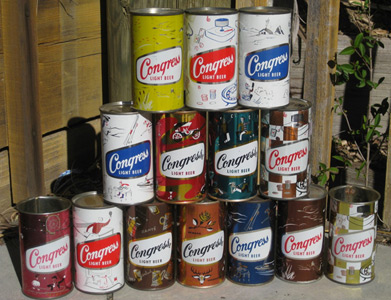 |
These Congress scene cans were produced by Continental Can. Continental's plant in Syracuse during part of the 1950s was managed by Bill Smith, a long time Continental employee who last managed a Continental Can plant in Florida. Bill recalled in the 1970s that starting with the earliest cones, he had understood that Continental's headquarters in New York City had saved flats sheets, along with some can examples of all its brands but the bulk of those flat sheets and cans apparently have never been uncovered. Top | |
H is for Hohenadel Brewing located on Indian Queen Lane: (Sept/2011) A smaller-sized Philadelphia Brewery that actively canned beer in over 10 different Hohenadel and Indian Queen labels: several crowntainers, 12oz J spouts, high profile cones, and in quarts. Among the rarer labels in on-grade condition is the Indian Queen Ale J spout. On-grade Indian Queen Ale cans oddly may not have been in any of the "original" Eastern collections, Oest, Allis, Veselsky, Anderson, etc. and were rarely seen until in the early 1980's when four examples turned up, plus a few more since that time.
|
||
Dave Lang has mentioned finding in dumps a number of Indian Queen Ales, 12oz and quarts, at several places in Mass. (as has Keith Norton), New Hampshire, and Maine. Dave thinks the quality of the label coating was high since number of cans found were still in very good shape. The Hohenadel label in cans have been more common with at least one group of "inside" 12oz J spouts being found, but the white crowntainer has been scarce. Top |
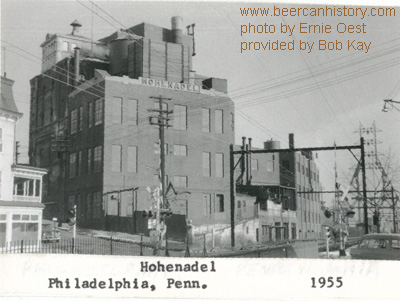 |
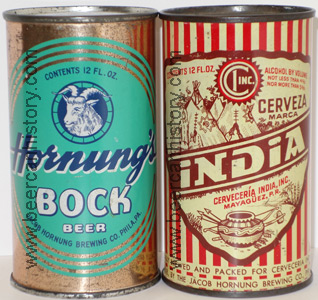 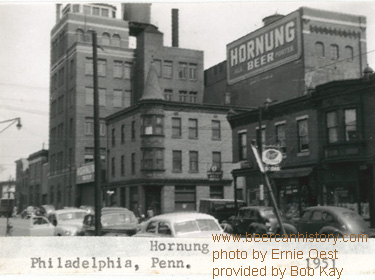 |
H is for Hornung Bock: (Sept/2011) Hornung was a small Philadelphia brewery on 22nd St. that went out of business in 1954, but per Will Anderson had two canning lines, which accounts for the good variety of cans produced. When Will Anderson sold his collection in 1981 by a mail bid auction, a Feb., 1982 Beer Cans Monthly summary of the sales showed his Gibbons Bock sold for $3750, and the "green" Hornung Bock was the next highest sale, at $2100. India was the main brand for a Puerto Rican brewery and apparently that brewery's first label in cans was this can label filled by Hornung. A few years later, a similar label design was used on a can filled by the brewery in Puerto Rico. Greg Stinza, an active collector from the 1980s to around 2005 advertised widely and located this can which was found originally by a person in the framing of their home, protected from the weather. This brand is one of the earliest examples of an American brewery filling beer for the Hispanic market; another slightly earlier example was a copper Schlitz flat top for "Export." Top |
| H is for Humboldt: (Sept/2011) Humboldt Malt and Brewing, Eureka, Calif. was a small brewery set up (per Jack Nash, BCCA#1016 and President of Eureka Historical Society) by an ownership group outside of Eureka who wanted to produce beer from the waters of a special spring in the south part of town. The brewery was named for the local county. | 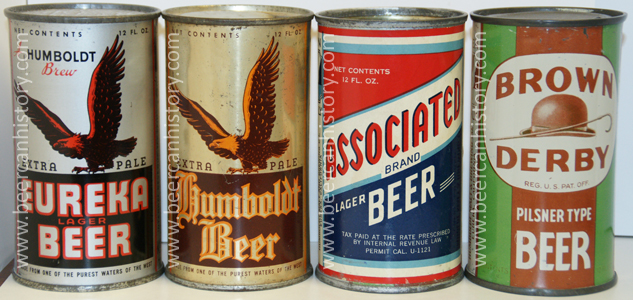 |
| The brewery had several different can brands, Associated, Eureka, and Brown Derby. Per Beer USA by Will Anderson, Western States Grocery Co. (later Safeway, which emphasized the Brown Derby brand) signed in 1933 a 10 year contract to buy the brewery's entire output. This Humboldt can was pictured in the Class book prepared by Jeff Cameron. Top | |
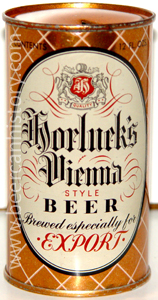 |
H is for Horluck's: (Sept/2011) This can was one of two held by a woman in a town just on the "dry side" of the mountains east of Seattle and located by BCCA member Greg Stinza through his advertising contacts. She set them aside in her basement around 1940 and thought they stayed in top condition due being in the drier area where she lived. Top |
  |
|
| J is for John Bull: (Sept/2011) From a small brewery in New Philadelphia, Ohio; while scattered examples of the high profile version of this label have been found, this low profile variation has been less seen and was in several collections, such as Joe Veselsky's and Will Anderson's, among other a few others. Top | |
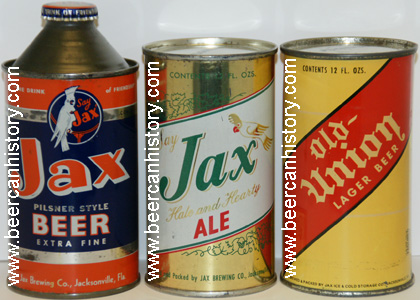 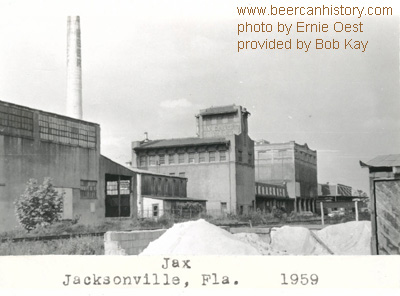 |
|
| J is for Jax Beer: (Sept/2011) The Jax brand was produced by two breweries in the South, and due to humidity, retaining most of the silver trim is rare for this late 1940's cone from Jacksonville, Florida was found by Dick Caughey. Top |
| J is for Jolly Scot Ale: (Sept/2011) The Robert H. Graupner Brewery of Harrisburg, Penna. operated until 1951 and had several brands in "J spouts" in the 1930's, among which were these two. Dick Caughey bought this Jolly Scot example from Fred Goodhart, a well regarded collector in Lexington, VA during November, 1991 - along with several other top shape cones such as SB. | 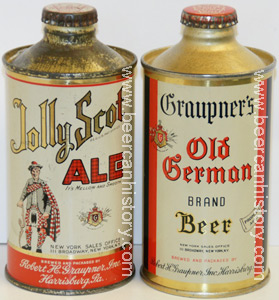 |
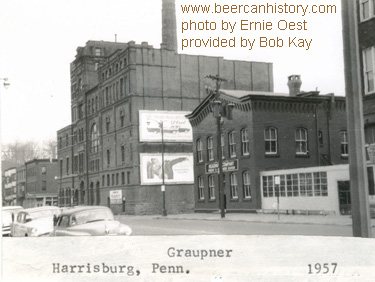 |
Where Fred found this Jolly Scot isn't known directly, but this example could be the one that reportedly was found among "159 cans found in New Jersey, 1980", described in April/May 2007 BCCA article by Matt Menke. The can lists a "New York Sales Office" at 111 Broadway, which is the building just north of the Trinity Church. Top
|
| [Back to Home] | |
| Copyright © 2007-2012 www.beercanhistory.com, All Rights Reserved. Last modified February 18, 2013. | |